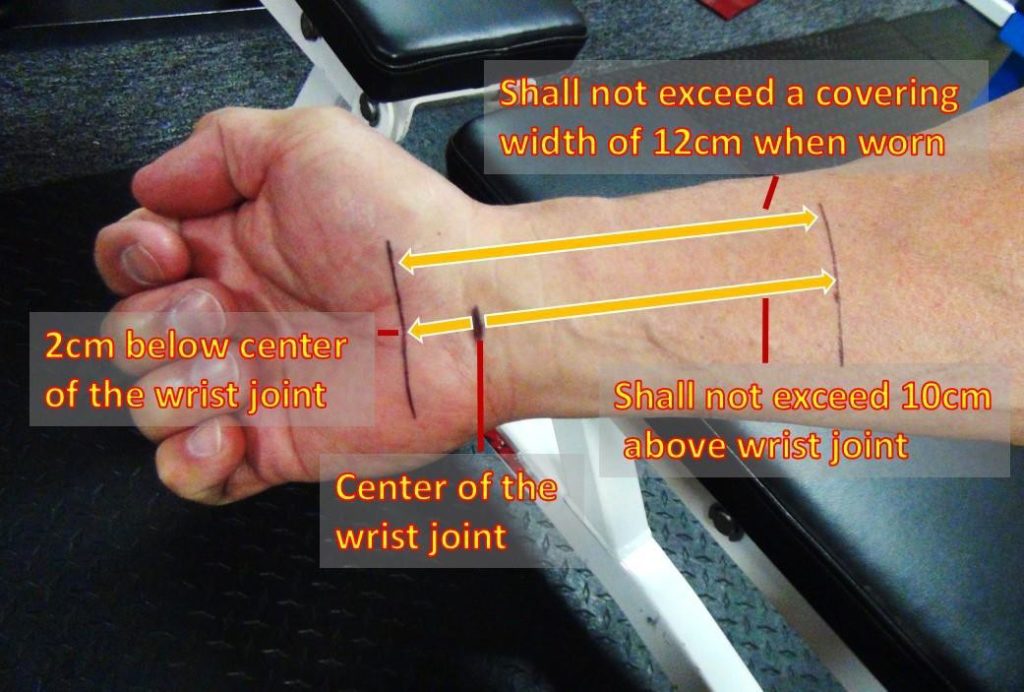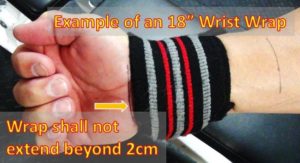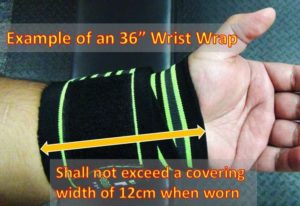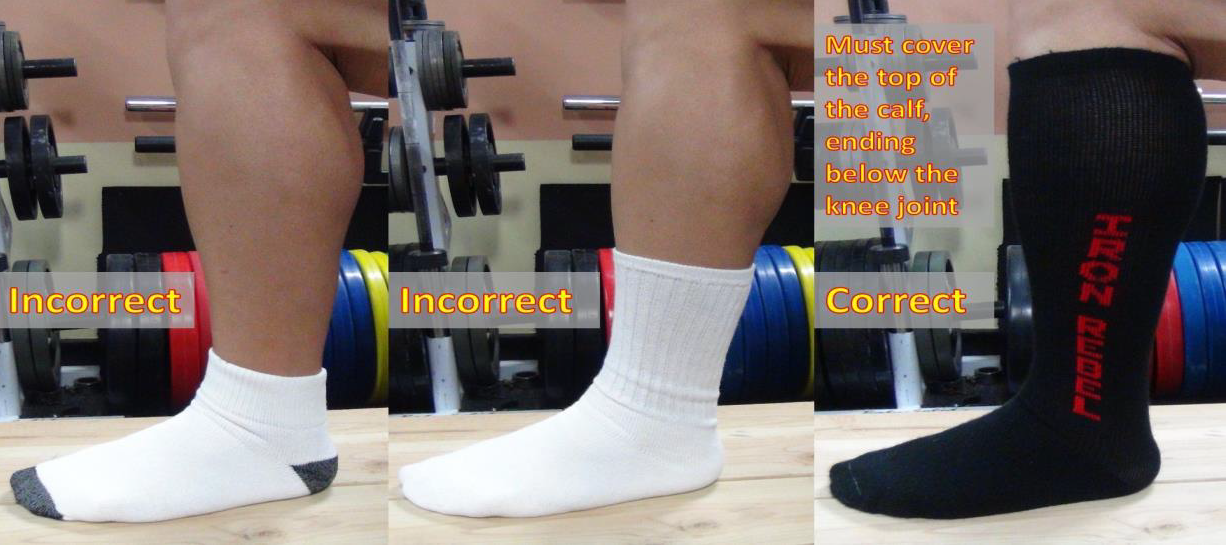This document is a digital representation of the official IPL Rulebook. This document has been digitized to permit automatic translation of this document. This document is provided as a reference. In ALL instances, please refer to the official IPL Rulebook, which can be found here: Official IPL Rulebook.
PART 3. COSTUME AND PERSONAL EQUIPMENT
Item 1. Singlet
3.1.1 The singlet shall consist of a one-piece full-length-lifting suit of single-ply stretch material that is non-supportive. Supportive is defined as either the type of material used in the construction of the garment, or the excessive tightness of the garment when worn by the lifter, or a combination of the two. The construction of the suit must be without any patches or padding. Any seams, false or otherwise, that in the opinion of the referees are incorporated into the costume purely as a form of reinforcement or bracing, shall invalidate the costume from being used in the competition. The costume must be form fitting without any looseness when worn by the lifter. The straps must be worn over the shoulders at all times while lifting in competition.
3.1.2 It may be of any color or colors and may not have any pockets, buttons, zippers, or a reinforced collar or seams.
3.1.3 The singlet may bear the badge, emblem, logo and/or inscription of the lifter’s nation, national association, or sponsor. That which is offensive or liable to bring the sport into disrepute is not allowed. No part of the lifter’s costume can bear the name, logo, or image or any other powerlifting organization other than the IPL and its affiliate countries.
3.1.4 The non-supportive weightlifting/wrestling-type suits may have a double thickness of the same material, however, must be size 12 cm x 24 cm or smaller and in the area of the crotch only.
3.1.5 It must have legs and the length of the leg must not extend below mid-thigh or be shorter than 2 in from the crotch. The mid-thigh measurement is to be taken on a line from the top of the knee to the crotch.
3.1.6 A singlet is required to be worn by all lifters during the bench, as well as any lifter not wearing a squat or deadlift suit during their respective lifts.
3.1.7 Any singlet with straps that have been shortened, in any fashion that may leave the excessive material intact, may not stitch or reattach the excess material back down to the suit itself. The
maximum amount the excess fabric (“tabs”) may extend is two inches above the new seam. Velcro is not allowed on the straps or any part of the singlet. Zippers are not allowed on singlets.
Item 2. Lifting Costume
3.2.1 The lifting costume (commonly known as a bench shirt, squat suit or deadlift suit) shall consist of a one-piece costume of single-ply material. The construction of the suit must be without any patches or padding and have a maximum overall material thickness not exceeding 1.3 mm at any measured point, except at any seam. Any seams, false or otherwise, that in the opinion of the referees are incorporated into the costume purely as a form of reinforcement or bracing, shall invalidate the costume from being used in the competition. The straps must be worn over the shoulders at all times while lifting in competition.
3.2.2 The lifting costume shall also be subject to the following requirements:
3.2.3 It may be of any color or colors.
3.2.4 The lifting costume may bear the badge, emblem, and/or inscription of the lifter’s nation, national association, manufacturer’s logo or sponsor. That which is offensive or liable to bring the sport into disrepute is not allowed. No part of the lifter’s costume can bear the name, logo, or image of any other powerlifting organization other than the IPL and its affiliate countries.
3.2.5 Seams and hems must not exceed 3 cm in width and 0.5 cm in thickness.
3.2.6 Seams may be protected or strengthened by narrow gauge webbing or stretch material not exceeding 2cm in width and 0.5 cm in thickness.
3.2.7 Any alterations to the costume, which exceed the established widths, lengths or thickness previously stated, shall make the suit illegal for competition.
3.2.8 Any lifting costume in which straps have been shortened in any fashion that may leave the excessive material intact, may not stitch or reattach the excess material back down to the suit itself. The maximum amount the excess fabric (“tabs”) may extend is 2 in above the new seam. Velcro is not allowed on the straps or any part of any lifting costume in either the Raw or Single Ply divisions, with the only exception being allowed on open-back bench shirts (see 3.3.6).
Item 3. Bench Shirt
3.3.1 Single-ply bench shirts may only consist of a single-ply and must, as a whole, be of single
material construction. The shirt cannot have an open back. The multi-ply (consisting of more than one layer) bench shirt may be open back and consist of multiple layers.
3.3.2 These and similar shirts are not permitted to be worn for the execution of other lifts under any circumstances. Only an undershirt as defined in the rules shall be worn during the squat and optionally in the deadlift.
3.3.3 Does not consist of any rubberized or similar stretch material or threading. It must
be made either exclusively of cotton or polyester, or a mixture of cotton and polyester. Denim is allowed; however, canvas material is not permitted.
3.3.4 Is not constructed so as to place seams in a position, which, in the opinion of the IPL contest official, might tend to assist the lifter in powerlifting competition.
3.3.5 It shall not have sleeves that terminate below the elbow when worn while the lifter’s arms are extended down at their sides. Note: Sleeves that extend below the elbow cannot be rolled up above the elbow; this would be considered multi-ply.
3.3.6 Velcro is allowed to fasten the shirt to the lifter. Velcro can only be placed on the back of the shirt and must close the back of the shirt completely. It cannot go around the lifter; this would make it multi-ply.
3.3.7 Patches or stitching may not be added anywhere on the lifter’s shirt that may give the lifter an unfair advantage.
3.3.8 All other material, construction, seams, and specifications found in “Item 2 Lifting Costume” apply.
3.3.9 When worn by the lifter, the shoulders of the shirt must cover the deltoids, and the lowest point of the front neckline cannot be below the nipple line. The collar on the front of the shirt cannot be any wider than 1.25 in.
3.3.10 The bench shirt may have additional non-supportive loops designed to facilitate securing the sleeves in place. They are sewn into the back side of the bench shirt directly behind the triceps. The loops are constructed of polyester material or nylon webbing and are not to exceed a width of
3.81 cm and length of 8.89 cm. The loop must consist of single-ply material and be
attached in a loose fashion so as to permit the use of a hand or mechanical hook. Constructed of single-ply material, the loop thickness may not exceed (0.125 cm).
Item 4. Erector Shirts (allowed in Multiply only)
3.4.1 The “erector” shirt can only be used during the squat and deadlift in the Multi-ply division only.
Item 5. Undershirt
3.5.1 An undershirt (t-shirt) with or without sleeves must be worn under a raw lifter’s singlet, and an equipped lifter’s squat suit, during the performance of the squat. A t-shirt must be worn under a raw lifter’s singlet during the bench press but is not allowed to be worn under a bench shirt. While performing the deadlift, women are required to wear a minimum of a sports bra, and a t-shirt is optional for both men and women. The undershirt is subject to the following provisions:
3.5.2 It can be of any color or colors, but may not have any pockets, buttons, zippers or a reinforced collar or seams.
3.5.3 It is not ribbed and does not consist of any rubberized or similar stretch material or threading. The t-shirt must be made either exclusively of cotton or polyester, or a mixture of cotton and polyester.
3.5.4 Is not constructed so as to place seams in a position, or have any reinforced seams which, in the opinion of the IPL contest official, might tend to assist the lifter in powerlifting competition.
3.5.5 It may have sleeves, or be sleeveless, tank tops are not allowed. The sleeve length may not extend below the elbows while the lifters arms are down at their sides.
3.5.6 Fits loosely enough on the lifter’s body to ensure that it does not afford the lifter any physical support.
3.5.7 It may not be worn under a bench press shirt. It must be an individual article of cloth.
The t-shirt may be the official t-shirt of the contest in which the lifter is competing or have any design that is not offensive or likely to bring the sport into disrepute.
Item 6. Underwear
3.6.1 Underwear – A standard commercial “athletic supporter” or standard commercial underwear of any mixture of cotton, nylon or polyester may be worn under the singlet or lifting costume while competing in either a raw, single-ply, or multi-ply competition. It is optional that a lifter wear underwear during a competition.
3.6.2 All underwear will be traditional “brief” style with no legs, also known as having a “V” cut leg opening.
3.6.3 Any lifter competing while wearing any type of supportive underwear, or underwear that is not a legless brief style, may be removed from the meet for deliberately attempting to cheat.
Item 7. Support Briefs
3.7.1 Support briefs may be worn in multi-ply competitions only.
The support brief may not extend beyond the lifter’s mid-torso, nor extend beyond mid-thigh.
3.7.2 They may be of multiple plies to any thickness but must as a whole be a single component.
Item 8. Socks
3.8.1 Only one pair of socks may be worn at a time.
3.8.2 They may be of any color or colors.
3.8.3 They shall not be of such length on the leg that they come in contact with the knee or meet any knee wrapping or knee sleeve when in use.
3.8.4 Full-length leg stockings, tights or hose are strictly forbidden.
3.8.5 During the execution of the deadlift, one pair of knee-length socks must be worn. They must cover to the top of calf, ending just below the knee joint. See drawings below.
3.8.6. Duct tape may never be worn in place of a knee sock, but may be worn under the sock as a shin guard as long as all duct tape is covered by the sock.
Item 9. Belt
3.9.1 Competitors may wear a belt. It shall be on the outside of the lifting suit with the buckle in the front or rear of the lifter’s body. However, the lifter cannot wear the buckle of his belt at his back during the bench press.
3.9.2 Materials and construction are as follows:
3.9.3 The main body shall be made of leather, vinyl or other similar non-stretch material in one or more laminations, which may be glued, riveted and/or stitched together.3.9.4 It shall not have additional padding, bracing or supports of any material on the surface or concealed within the laminations of the belt.
3.9.5 A standard metal buckle and studs are the only non-leather components permitted, with the exception of the materials used in the “quick release” or ratchet-style mechanism. The buckle shall be attached at one end of the belt by means of studs and/or stitching.
3.9.6 The belt may have a buckle with one or two prongs, “quick release” type or ratchet style. Velcro is not allowed anywhere on the lifting belt.
3.9.7 A leather or vinyl tongue loop shall be attached close to the buckle by means of studs and/or stitching.
3.9.8 The names of the lifter, the lifter’s sponsor, or club may appear on the outside of the belt. They may be of any color or colors.
3.9.9 Width of belt may be a maximum of 10 cm. (#1 below)
3.9.10 Thickness of belt may be a maximum of 13 mm along the main length (#2 below), excluding any materials associated with the ratchet mechanism.
3.9.11 Inside width of buckle, maximum 11cm. (#3 below)
3.9.12 Outside width of buckle may be a maximum of 13 cm. (#4 below)
3.9.13 Tongue loop maybe a maximum width of 5 cm. (#5 below)
3.9.14 Distance between end of belt and far end of tongue loop may be a maximum of 15 cm. (#6 below)
Item 10. Shoes or Boots
3.10.1 Lifting shoes or boots shall be worn. They may be of any color or colors.
3.10.2 Shoes may include boots, sport shoes, gymnastic slippers or any foot covering that has a patterned molding or foot type outline that provides an inner sole.
3.10.3 Shoes with metal spikes or metal cleats are not permitted.
Item 11. Wrist & Knee Wraps/ Knee & Elbow Sleeves/Hats, Sweat Bands, Head Gear/Wrist Wraps
3.11.1 Only wrist wraps of one ply commercially woven elastic that is covered with polyester, cotton or combinations of either materials is permitted.
3.11.2 Wrist wraps may not exceed 1 m in length and 8 cm in width. Any sleeves, and Velcro
patches/tabs for securing, must be incorporated within the one-meter length. A loop may be attached as an aid to securing. The loop shall not cover the thumb or fingers during the lift.
3.11.3 A wrist wrap shall not extend beyond 10 cm above and 2 cm below the center of the wrist joint and shall not exceed a covering width of 12 cm when worn. No portion of the wrap may be in contact with the bar.
3.11.4 Standard commercial sweat bands may be worn, not exceeding 12 cm in width. A combination of wrist wraps and sweat bands is not allowed.
 |
 |
 |
Knee Wraps/Knee Sleeves
3.11.5 Only knee wraps of one ply not exceeding 2.5 m in length and 8 cm in width may be used. A knee wrap shall not extend beyond 15 cm above and 15 cm below the center of the knee joint and shall not exceed a total covered width of 30 cm.
3.11.6 Alternatively, a one-ply knee sleeve or knee wrap made from commercially available neoprene or woven elastic that is covered with polyester, cotton or combinations of either materials of not more than 30 cm in length, and not exceeding 7 mm in thickness. Knee sleeves cannot have any crisscross seams that allow additional support. The placement of the sleeve is the same as in 3.11.5
3.11.7 Raw lifters may only use the optional single ply knee sleeve during their lift, and it may not have any Velcro on it, must be both non-adjustable and non-fastening.
3.11.8 Knee wraps and knee sleeves shall not be in contact with the socks or lifting suit.
3.11.9 Wraps shall not be used elsewhere on the body.
3.11.10 A combination of a knee wrap and knee sleeve is strictly forbidden.
Hats, Sweat Bands, Head Gear
3.11.11 Hats and dew rags are strictly forbidden to be worn on the lifting platform.
3.11.12 Head sweat bands are allowed with the maximum width of 10 cm.
3.11.13 Lifter safety prohibits the use of any type of head phone or ear plug to be used while on the platform.
Medical Tape/Bandages
3.11.14 Two layers of bandages or band-aids may be worn by the lifter during the performance of all three lifts after receiving permission from the Head Referee validating the medical necessity to use them. However plasters, bandages or band-aids may not be used as aids to the lifter in the performance of the lift or in holding the bar.
3.11.15 Contingent upon prior approval by the Head Referee the lifter or medical personnel may apply bandages or wraps to bodily injuries in a fashion that would not grant the lifter an undue advantage.
3.11.16 At all competitions where no medical personnel are on duty, the Head Referee shall have jurisdiction over the use of all medical tapes and bandages.
3.11.17 All medical letters in support of a lifter request to allow the use of medical tape or bandages during their lifts should be presented to the Head Referee prior to the start of the meet for his determination as to its legality under the rules.
3.11.18 The use of kinesiology tape (KT tape) or similar tapes is not allowed.
Elbow Sleeves:
3.11.19 Elbow sleeves made from commercially available neoprene or woven elastic that is covered with polyester, cotton or combinations of either materials not exceeding 20 cm in length and 7 mm in thickness may only be worn in the squat and deadlift. Lifters may only use the optional single-ply elbow sleeve during their lift. It may not have any Velcro on it and must be both non-adjustable and non-fastening.
3.11.20 The placement of the sleeve shall be approximately 10 cm above, and 10 cm below the elbow joint. The t-shirt sleeve may overlap the elbow sleeve as long as it does not extend below the lifter’s elbow.
3.11.21 Elbow cuffs may only be worn directly centered on the lifter’s elbow when the arm is bent at a 90-degree angle. They may not be worn as tendonitis bands on the lifter’s forearm. All other specs found in sections 3.11.19 and 3.11.20 also apply.
Item 12. Blood Management
3.12.1 Blood or open wounds are not allowed on a lifter while on the platform. Any injuries must be treated and bandaged prior to a lifter’s attempt. Should blood come in contact with the bar or
equipment, the lifting shall be stopped, and the bar or equipment sterilized with a bleach solution, hydrogen peroxide, or isopropyl alcohol. It is the Meet Director’s responsibility to have such a solution present at the competition.
3.12.2 If a lifter appears on the platform with any blood or open wounds showing it will be their responsibility to correct the problem before being allowed to continue with their lift. The time clock will remain running; should they be unable to correct the problem before their time runs out,
they will forfeit the attempt.
Item 13. Shin Guards
3.13.1 Shin guards may only be used during the deadlift and must be worn under the socks. Items such as duct tape, plastic inserts, knee or elbow sleeves, or other materials no greater than 10 mm in thickness, that will protect the lifters shin during the performance of the deadlift, without giving any unfair advantage, may be worn. All forms of a shin guard must be fully covered by the approved lifter’s deadlift sock.
Item 14. Raw, Classic Raw, Single Ply and Multiply Equipment Definition
3.14.1 The approved costume and equipment allowed for the raw division competitions will be defined as a non-supportive, one piece, single-ply singlet (Part 3, Item 1), a t-shirt (Item 5), optional underwear (Item 6), socks (Item 8), optional belt (Item 9), shoes (Item 10), and optional single-ply wrist wraps, elbow sleeves, and knee sleeves.
(Item 11). Knee wraps of any length are not allowed. The Rules of Performance for all three lifts are the same for Raw, Classic Raw, Single-ply and Multiply competitors.
3.14.2 The approved costume and equipment allowed for the classic raw division competitions will be defined as a non–supportive, one piece, single-ply singlet (Part 3, Item 1), a t-shirt (Item 5), optional underwear (Item 6), socks (Item 8), optional belt (Item 9), shoes (Item 10), and optional single-ply wrist wraps, elbow sleeves, and knee wraps up to 2.5m (item 11). The Rules of Performance for all three lifts are the same for Raw, Classic Raw, Single-ply and Multiply competitors.
3.14.3 The approved costume and equipment allowed for the single-ply division competitions will be defined as a supportive, one piece, single-ply squat, bench, and deadlift suit (Part 3, Item 2 and 3), a t-shirt (Item 5), optional underwear (Item 6), socks (Item 8), optional belt (Item 9), shoes (Item 10), and optional single-ply wrist wraps, elbow sleeves, and knee wraps up to 2.5 m (item 11). The Rules of Performance for all three lifts are the same for Raw, Classic Raw, Single-ply and Multiply competitors.
3.14.4 The approved costume and equipment allowed for the multiply division competitions will be defined as a supportive, one-piece, multi-ply squat, bench, and deadlift suit (Part 3, Item 2 and 3), a t-shirt (Item 5), optional underwear (Item 6), socks (Item 8), optional belt (Item 9), shoes (Item 10), and optional single-ply wrist wraps, elbow sleeves, and knee wraps up to 2.5m (item 11). The Rules of Performance for all three lifts are the same for Raw, Classic Raw, Single-ply and Multiply competitors.
Item 15. Inspection of Costume and Personal Equipment
3.15.1 Equipment inspections are required and will take place during the weigh-in periods.
It is the lifter’s responsibility to bring all equipment intended for use during the meet to their weigh-in session and have it inspected by an official. If after the inspection, a lifter appears on the platform wearing or using any illegal item or article not approved, the lifter may immediately be disqualified from the competition.
3.15.2 Knee wraps, wrist wraps, or the legs on underwear over permitted length shall be rejected but may be cut to correct length and resubmitted within the specified inspection time. It is the lifter’s responsibility to cut any item not in compliance and bring them within proper specs. The examining referee is not permitted to perform this service.
3.15.3 Any item considered unclean or torn shall be rejected. Lifters may not appear on the platform while wearing torn apparel.
3.15.4 All items mentioned previously under Costume and Personal Equipment shall be inspected prior to the competition together with any other items such as headbands, mouthpieces, ribbons, etc. that the lifter may wish to wear on the platform. Hats are strictly forbidden and may not be worn on the platform during lifting. Items such as watches, costume jewelry, eyewear and feminine hygiene articles need not be inspected.
3.15.5 Any lifter successful in a Regional, National or World record attempt must immediately present themselves to one of the three referees for inspection. If the lifter is found to be wearing illegal items, the lift shall be declared invalid and the lifter may be disqualified from the competition. If during this inspection a referee cannot determine the legality of an items or believes the lifter to be in violation of one or more of the equipment rules, the lifter will be taken to a private area and thoroughly inspected by two meet officials of the same gender as the lifter to determine the legality of all equipment.
Item 16. General
3.16.1 The use of oil, grease or other lubricants on the body, costume or personal equipment is strictly forbidden.
3.16.2 The use of any form of adhesive, or any other substance on the underside of shoes or boots is strictly forbidden. Lifters will be allowed to wipe their shoes off on a wet towel just prior to stepping on the platform.
3.16.3 Baby powder, pool hall chalk, liquid chalk, resin, talc or magnesium carbonates are the only substances that may be added to the body and attire. The Meet Director may limit its application to a designated area only.
3.16.4 No foreign substances may be applied to the equipment or wraps. Nothing may be purposely applied to the platform, bench, or bars.
3.16.5 The uses of substance like ammonia caps, smelling salts, etc. cannot be used anywhere near the lifting platform or in view of the audience.





